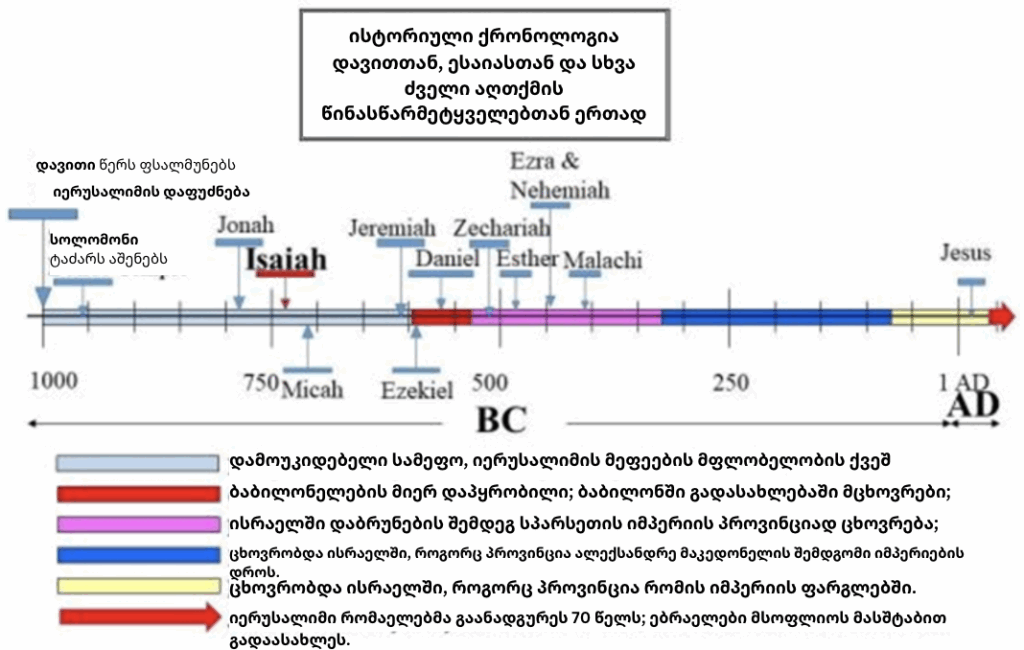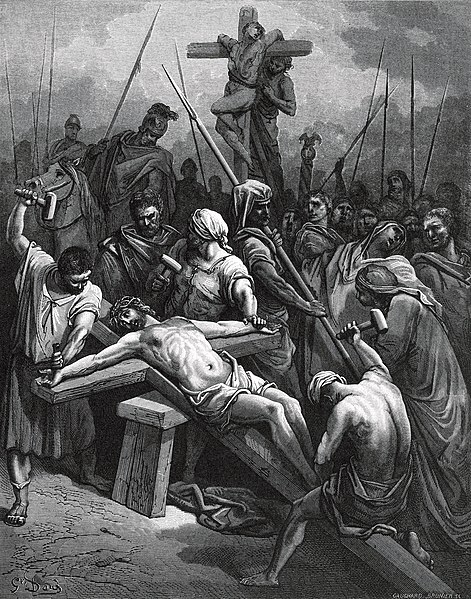რამდენიმე წლის წინ ჩემი კოლეგა, ჯ., ჩემს მაგიდასთან მოვიდა. ჯ. ჭკვიანი და განათლებული იყო – და ნამდვილად არ იყო სახარების მიმდევარი. თუმცა, ის გარკვეულწილად ცნობისმოყვარე იყო სახარების მიმართ, ამიტომ ჩვენ შორის თბილი და ღია საუბარი გვქონდა. მას არასდროს შეუსწავლია ბიბლია, ამიტომ მე წავახალისე, რომ გამოეკვლია იგი.
ერთ დღეს ის ჩემს კაბინეტში შემოვიდა ბიბლიით ხელში, რათა ეჩვენებინა, რომ ათვალიერებდა. შემთხვევით შუაში ჰქონდა გადაშლილი. ვკითხე, რას კითხულობდა. ჩვენი საუბარი დაახლოებით ასე წარიმართა.
„ ფსალმუნის 22-ე თავს ვკითხულობ “, – თქვა მან.
„მართლა“, – ვთქვი მე. „წარმოდგენა გაქვს, რას კითხულობ?“
„ალბათ, იესოს ჯვარცმაზე ვკითხულობ“, უპასუხა ჯ.-მ.
„კარგი ვარაუდია“, – გამეცინა მე. „მაგრამ თქვენ დაახლოებით ათასი წლით ადრე ხართ. ფსალმუნი 22 დავითმა დაწერა დაახლოებით ძვ. წ. 1000 წელს. იესოს ჯვარცმა ახ. წ. 30-იან წლებში მოხდა ათასი წლის შემდეგ“.
ფსალმუნები…
ჯ.-მ ვერ გააცნობიერა, რომ ფსალმუნები არ იყო იესოს ცხოვრების შესახებ სახარებისეული ჩანაწერები, რომლებიც მისმა თანამედროვეებმა დაწერეს. ფსალმუნები იყო წმინდა ებრაული ჰიმნები, რომლებიც იესომდე 1000 წლით ადრე, ძირითადად მეფე დავითის მიერ იყო დაწერილი . ჯ.-მ მხოლოდ რამდენიმე ისტორია მოისმინა იესოს შესახებ, მათ შორის მისი ჯვარცმის შესახებ, და შემთხვევით გადაშალა ბიბლია და წაიკითხა, რომელიც, როგორც ჩანს, ჯვარცმის აღწერას შეესაბამებოდა. უკეთ რომ არ იცოდა, მან უბრალოდ იფიქრა, რომ ეს იყო ჯვარცმის ისტორია, რომელსაც მსოფლიოს მრავალი ადამიანი ყოველწლიურად დიდ პარასკევს იხსენებს . ბიბლიის კითხვისას მის პირველ შეცდომაზე სიცილი აგვიტყდა.

შემდეგ ვკითხე ჯ.-ს, რა დაინახა ფსალმუნის 22-ე თავში ისეთი, რამაც იესოს ჯვარცმის შესახებ კითხულობდა. ასე დაიწყო ჩვენი მცირე კვლევა. გეპატიჟებით, განიხილოთ რამდენიმე მსგავსება, რომელიც ჯ.-მ შენიშნა ცხრილში მონაკვეთების გვერდიგვერდ განლაგებით. სახარებებში ჩაწერილი ჯვარცმის შესახებ თვითმხილველთა მონათხრობები მარცხნივ არის მოცემული. ფსალმუნი 22 მარჯვენა მხარესაა. მრავალ სიტყვაში კავშირების დასანახად, მსგავსი ტექსტები ფერადად შევახამე. ( გადიდებული ბეჭდური ვერსიის სანახავად დააჭირეთ აქ ).
ჯვარცმის შესახებ სახარებისეული ცნობების შედარება ფსალმუნის 22-ე თავში მოცემულ დეტალებთან
იხილეთ თარგმანი სურათის ქვევით

ტექსტის თარგმანი:
ჯვარცმის დეტალები მოწმის სახარებებიდან
(მათე 27:31-48) … შემდეგ იესუ წაიყვანეს, რათა ჯვარს ეცვათ…
39 ვინც იქ გაივლიდა, აგინებდნენ მას, თავს აქნევდნენ
40 და ამბობდნენ: „ხსენი თავი! ჩამოდი ჯვრიდან, თუ ღვთის ძე ხარ!“
41 ასევე ქურუმთა უფროსნი და მწიგნობარნი და უხუცესნი დამასკებოდნენ მას.
42 „სხვა იხსნა, თავი კი ვერ იხსნის! ისრაელის მეფეა! ჩამოვიდეს ახლა ჯვრიდან და ვირწმუნებთ მას.
43 იგი ღმერთს ენდობოდა. დაე, ღმერთმა იხსნას იგი, თუ უნდა მას…
46 …და მეცხრე საათზე იესომ ხმამაღლა იყვირა: „ღმერთო ჩემო, ღმერთო ჩემო, რად მიმატოვე?“
48 მაშინვე ერთმა მათგანი სარი მოიტანა, ძმარში ამოავსო და სასმელად მისცა.
(მარკოზი 15:16-20)
16 ჯარისკაცებმა წაიყვანეს იგი… მოასვეს მას იისფერი სამოსი და მოახვიეს ეკლის გვირგვინი.
18 და დაიწყეს მის მიმართ ძახილი: „მოგესალმები, იუდეველთა მეფეო!“
19 და მუხლებზე დავარდნილნი ემხობოდნენ მას.
20 როდესაც დასცინეს, შეაცვეს სამოსი და თავის ტანსაცმელი ჩააცვეს და წაიყვანეს ჯვარზე შესაკრავად.
(იოანე 19:30-37)
30 ხმამაღლა შესძახა იესომ და სული დალია.
34 ერთმა ჯარისკაცმა შუბით განგმირა მისი გვერდი და მაშინვე გამოვიდა სისხლი და წყალი.
…25 „თუ არ ვიხილავ მის ხელებზე ლურსმნის ნიშანს…“
…23 ჯარისკაცებმა, როცა ჯვარს აცვეს იესუ, აიღეს მისი ტანსაცმელი და გაყოფეს ოთხ ნაწილად… და ტუნიკა – „არ დავხიოთ, ნატეხისათვის წილი ვყაროთ,“ თქვეს.
ფსალმუნი 21 (22): 1000 წ. ქრისტესმდე
1 ღმერთო ჩემო, ღმერთო ჩემო, რად მიმატოვე?
შორს არის ჩემი ხსნა ჩემი ღაღადისისაგან.
2 ღმერთო ჩემო, დღისით მოგიხმობ და არ ისმენ, ღამითაც, და არა არის ჩემთვის სიწყნარე.
7 ყველა, ვინც მხედავს, დამცინის,
8 აგინებენ და თავს აქნევენ:
„იგი უფალს ენდობოდა, დაე, გადაარჩინოს იგი! დაე, იხსნას იგი, რადგანაც მას სურდა!“
14 მე წყლად დავიღვარე და ყველა ძვალი ჩემი გაიშალა.
15 გული ჩემი ცვილის მსგავსად დადნა ჩემს გულში.
16 ძაღლნი მეხვევიან, ბოროტთა კრებული მიცემს გარემოს; გამიღეს ხელნი და ფერფლნი.
17 შემოსჩანს ძვალნი ჩემნი,
მხედველნი დამცინიან და თვალებით მასხარაობენ.
18 გაანაწილეს სამოსი ჩემი თავის შორის და სამოსზე წილი ყარეს.
ის ფაქტი, რომ ჯ.-მ ლოგიკური, მაგრამ არასწორი დასკვნა გააკეთა, რომ ფსალმუნი 22-ე იყო დიდი პარასკევის ჯვარცმის თვითმხილველის მონათხრობი, კითხვის დასმის საფუძველს გვაძლევს.
როგორ ავხსნათ მსგავსება ჯვარცმის შესახებ ცნობებსა და ფსალმუნის 22-ე მუხლს შორის?
დამთხვევაა, რომ დეტალები იმდენად ზუსტად ემთხვევა ერთმანეთს, რომ 22-ე ფსალმუნიც და სახარებაც სამოსს იყოფს? თუმცა ორივე წილისყრითაც ყარს (უნაკერო სამოსის დახევა მას გაანადგურებდა, ამიტომ ჯარისკაცები მასზე ფსონს იხდიდნენ). 22-ე ფსალმუნი ჯვარცმის გამოგონებამდე დაიწერა, თუმცა მასში აღწერილია მისი სხვადასხვა დეტალი (ხელებისა და ფეხების გახვრეტა, ძვლების სახსრების აშლა – მსხვერპლის ჩამოხრჩობისას დაჭიმვით).
გარდა ამისა, იოანეს სახარებაში ნათქვამია, რომ ჯარისკაცებმა იესოს ფერდში შუბი ჩაარჭეს, როდესაც სისხლი და წყალი გადმოვიდა. ეს გულის გარშემო სითხის დაგროვებაზე მიუთითებდა. ამრიგად, იესო გულის შეტევით გარდაიცვალა. ეს ემთხვევა ფსალმუნის 22-ე მუხლში აღწერილობას, სადაც ნათქვამია: „ჩემი გული ცვილად იქცა“.
ფსალმუნი 22-ე იკითხება, როგორც ჯვარცმის შესახებ პირველ პირში მოთხრობილი ისტორია. სახარებები კი მესამე პირის თვითმხილველის ცნობებს ჰგავს. ორივე კომპლექტი ემთხვევა ერთმანეთს.
როგორ?
ღვთისგან შთაგონებული ახსნა ფსალმუნი 22-ისთვის
სახარებებში იესო ამტკიცებდა, რომ ეს მსგავსებები წინასწარმეტყველური იყო. ღმერთმა ძველი აღთქმის წინასწარმეტყველებს შთააგონა იესოს ცხოვრებამდე ასობით წლით ადრე, რომ ეწინასწარმეტყველებინათ მისი ცხოვრებისა და სიკვდილის დეტალები, რათა ჩვენ შეგვეძლოს ვიცოდეთ, რომ ეს ყველაფერი ღვთის გეგმაში იყო. წინასწარმეტყველური ასრულება დიდი პარასკევის ამ მოვლენებზე ღვთაებრივი ხელმოწერის ქონას ჰგავდა, რადგან ვერცერთ ადამიანს არ შეეძლო მომავლის ასე დეტალურად განჭვრეტა. ეს ღვთის საქმისა და ისტორიაში ჩარევის დასტურია.
ფსალმუნის 22-ე თავის ნატურალისტური ახსნა
სხვები ამტკიცებენ, რომ ფსალმუნის 22-ე თავისა და დიდი პარასკევის ჯვარცმის მოვლენებს შორის მსგავსება იმით არის განპირობებული, რომ სახარების ავტორებმა მოვლენები წინასწარმეტყველების „შესაბამისად“ შეთხზეს. თუმცა, ეს ახსნა სრულიად უგულებელყოფს იმ დროის ისტორიკოსების მოწმობას ბიბლიის გარეთ. იოსებ ფლავიუსი და ტაციტუსი შესაბამისად გვეუბნებიან, რომ:
„ამ დროს ცხოვრობდა ერთი ბრძენი კაცი… იესო… კეთილი და… სათნო. და მრავალი ადამიანი იუდეველთაგან და სხვა ხალხებიდან გახდა მისი მოწაფე. პილატემ იგი ჯვარცმასა და სიკვდილს მიუსაჯა.“იოსებ ფლავიუსი. 90 ჩვ. წ.სიძველეებიxviii. 33. იოსებ ფლავიუსი ებრაელი ისტორიკოსი იყო.
„ქრისტოსი, სახელის დამაარსებელი, სიკვდილით დასაჯა პონტიუს პილატემ, იუდეის პროკურორმა ტიბერიუსის მეფობის დროს“ტაციტუსი. 117 წ. წ.ანალებიXV. 44. ტაციტუსი რომაელი ისტორიკოსი იყო.
მათი ისტორიული ჩვენება ემთხვევა სახარებებს, რომ იესო ჯვარს აცვეს. ეს მნიშვნელოვანია, რადგან ფსალმუნის 22-ე თავში მოყვანილი მრავალი დეტალი უბრალოდ ჯვარცმის აქტის დეტალებია. თუ სახარების ავტორები აპირებდნენ რეალური მოვლენების გამოგონებას, რათა ისინი ფსალმუნის 22-ე თავში „მოერგათ“, მაშინ მათ ფაქტობრივად მთელი ჯვარცმის გამოგონება მოუწევდათ. თუმცა, ებრაელი ისტორიკოსი იოსებ ფლავიუსი ცალსახად აცხადებს, რომ პილატემ ის ჯვარს აცვა.

ფსალმუნი 22 და იესოს მემკვიდრეობა
ასევე, ფსალმუნი 22 არ მთავრდება მე-18 მუხლში, როგორც ზემოთ მოცემულ ცხრილშია მოცემული. ის გრძელდება. ყურადღება მიაქციეთ ტრიუმფალურ განწყობას ბოლოს – ადამიანის გარდაცვალების შემდეგ!
‘ჭამონ ღატაკთ და გაძღნენ, ადიდონ უფალი მისმა მაძიებლებმა; სამარადჟამოდ იცოცხლონ თქვენმა გულებმა. გაიხსენებენ და უფალთან დაბრუნდებიან და თაყვანს სცემს ყველა ტომი ხალხებისა. რამეთუ უფალს შვენის მეფობა და ის არის ხალხთა მბრძანებელი. ჭამს და თაყვანს სცემს ამ ქვეყნის ყველა გათქვირებული, მის წინაშე ქედს მოიხრის ყველა, ვინც მტვრად უნდა იქცეს, ვისაც არ ძალუძს თავისი სულის გადარჩენა. შთამომავლობა ემსახუროს მას; მოუთხრობს თაობებს უფლის შესახებ. მოვლენ და მოუყვებიან მის სიმართლეს ხალხს, რაც მოიმოქმედა უფალმა.’
ფსალმ. 21:27-32
ეს არ ეხება ამ ადამიანის გარდაცვალების დეტალებს. ფსალმუნის დასაწყისი ამ დეტალებს ეხებოდა. ფსალმუნმომღერალი ახლა ამ ადამიანის გარდაცვალების მემკვიდრეობას „შთამომავლობასთან“ და „მომავალ თაობებთან“ დაკავშირებით განიხილავს (მუხლი 30).
ვინ იქნებოდა ეს?
ფსალმუნი 22-ში იესოს მემკვიდრეობა ჩვენს დრომდე იყო ნაწინასწარმეტყველები.
ეს ჩვენ ვართ, ვინც იესოს ჯვარცმიდან 2000 წლის შემდეგ ვცხოვრობთ. ფსალმუნმომღერალი წინასწარმეტყველებს, რომ „შთამომავლობა“, რომელიც ამ „გახვრეტილი“ კაცის ასეთ საშინელ სიკვდილს მოჰყვება, „ემსახურება“ მას და „მოითხრობენ მის შესახებ“. 27-ე მუხლი წინასწარმეტყველებს ზემოქმედების გეოგრაფიულ მასშტაბებს. ის „დედამიწის კიდეებამდე“ და „ხალხთა ყველა ოჯახამდე“ გავრცელდება, რათა ისინი „უფლისკენ მობრუნდნენ“. 29-ე მუხლი წინასწარმეტყველებს, რომ „ისინი, ვისაც საკუთარი თავის გადარჩენა არ შეუძლიათ“ (რადგან ჩვენ მოკვდავები ვართ, რაც ყველა ჩვენგანს ნიშნავს), ერთ დღეს მის წინაშე დაიჩოქებენ. ამ კაცის სიმართლე გაცხადდება იმ ადამიანებისთვის, რომლებიც მისი გარდაცვალების დროს ჯერ არ იყვნენ ცოცხლები („ჯერ არშობილები“).
ფსალმუნის 22-ე თავის დასკვნას არაფერი აქვს საერთო იმასთან, სახარებისეული ისტორიები ნასესხებია თუ შეთხზულია ჯვარცმის მოვლენები, რადგან ის ახლა გაცილებით გვიანდელ ეპოქას – ჩვენს დროს ეხება. I საუკუნეში მცხოვრებ სახარების ავტორებს არ შეეძლოთ იესოს სიკვდილის ჩვენს დრომდე „შეთხზვა“. როგორ შეეძლოთ მათ სცოდნოდათ, რა იქნებოდა ეს გავლენა?
იესოს მემკვიდრეობის შესახებ უკეთეს წინასწარმეტყველებას ფსალმუნის 22-ე მუხლზე უკეთ ვერავინ გააკეთებდა. მსოფლიო მასშტაბით დიდი პარასკევის ყოველწლიური აღნიშვნაც კი გვახსენებს მის გლობალურ გავლენას მისი გარდაცვალებიდან ორი ათასი წლის შემდეგ. ეს ფსალმუნის 22-ე მუხლების დასასრულს ისევე ზუსტად ასრულებს, როგორც წინა მუხლებში იყო მისი გარდაცვალების დეტალები ნაწინასწარმეტყველები.
მსოფლიო ისტორიაში კიდევ ვის შეუძლია თქვას, რომ მისი გარდაცვალების დეტალები, ისევე როგორც მისი ცხოვრების შორეულ მომავალში შემდგომი ნაბიჯები, მის სიცოცხლემდე 1000 წლით ადრე იქნებოდა ნაწინასწარმეტყველები?
ზედაპირის ქვეშ ნაკაწრი.
შესაძლოა, ჩემი მეგობრის, ჯ.-ს მსგავსად, თქვენც ისარგებლებთ შესაძლებლობით და დაფიქრდებით იესოს სიკვდილისა და აღდგომის მნიშვნელობაზე. ამას გარკვეული გონებრივი ძალისხმევა დასჭირდება. თუმცა, ეს ღირს, რადგან ფსალმუნის 22-ე მუხლში ნაწინასწარმეტყველები ადამიანი დაჰპირდა:
‘„ქურდი მხოლოდ იმისათვის მოდის, რომ მოიპაროს, მოკლას და მოსპოს. მე იმისთვის მოვედი, რომ სიცოცხლე ჰქონდეთ მათ და უხვად ჰქონდეთ. ‘
იოან. 10:10
ამის გაკეთების რამდენიმე გზა: